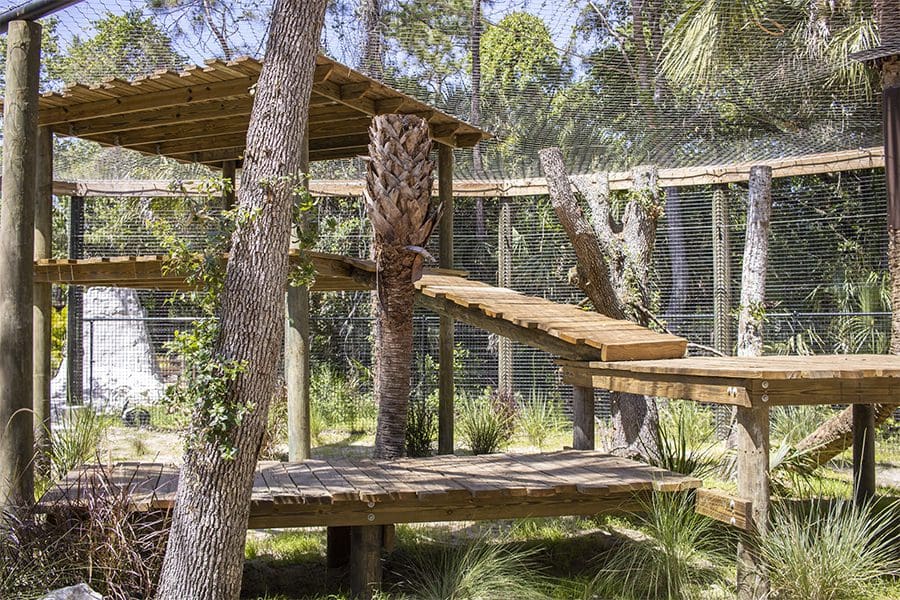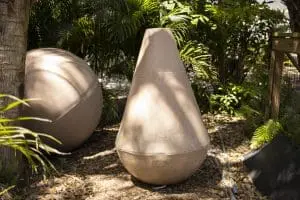

This lion habitat is full of climbing structures!
Editor’s note: This is the second in a trio of blogposts on the three lion brothers who now call our Zoo home. To read up on their history, please read this blogpost. To learn more about the work behind this move, please read this blogpost.
It’s easy to forget that these big, powerful brothers are still fairly young. This is a huge transition for them. We will give them the opportunity to explore their habitat Sunday, May 1, but our priority is their wellbeing. They will have access to their night houses to use if they feel nervous, so they may not always be visible. Please be patient with our trio as they continue to get used to their new home.
We know, we know – the lions were supposed to be here ages ago! Bringing in a new species, especially one as complex as lions, is not easy. Our Zoo staff worked hard to build a habitat that encouraged their natural behaviors while also keeping the lions and their animal care team safe.
Building for Lions

This habitat will be a temporary home for our lion brothers before a permanent space is created in Expedition Africa.
You may be wondering, “Why are the lions in Wild Florida?” That’s a great question! While our Expedition Africa section was the most logical home for our lions, there was no readily available, unoccupied space in the area. After countless meetings and conversations, we decided it best to formulate the following plan: Create a temporary lion habitat in Wild Florida and once complete, begin on a larger project to create a permanent lion habitat in Expedition Africa, which we expect to be complete in late 2023. Not to fret, once lions make the switch over to Expedition Africa, we will make use of the space in Wild Florida for another species!
Albeit temporary, building a habitat for three young lions was no easy feat. With help from contractors, the Zoo’s construction team created a large habitat, complete with a holding area. The work included sourcing appropriate materials, installing roofs and fencing, building custom perches, putting in camera systems, doing electrical work, establishing an appropriate locking system and much more. The project took longer than expected due to our team taking on the building of the holding area, but we promise, it’s worth the wait!
“Building habitats for animals takes a very unique skillset,” said Jon Brangan, the Zoo’s Deputy Director. “Our Zoo team was developed specifically for these projects.”

This holding area includes a permanent scale to get accurate weights of its resident.
Four behind-the-scenes holding areas were built – three to hold each of the lions and a fourth that includes a permanent scale to get weights of the animals. You can read more about the importance of scales and how we’re looking to improve ours.
“Safety was the most important thought for us during design of both the habitat and the holding area,” said Lauren Hinson, the Zoo’s Director of Animal Programs. “We opted to make it as simple and straight forward as possible. Making sure the lion boys had areas to do natural behaviors like rest, climb and sharpen their claws was also paramount.”
Preparing Our Animal Care Team
Because lions are a brand-new species at our Zoo, lots of prep work went into getting ready to care for them. Before their habitat was occupied, our animal managers and Expedition Africa team (who will be caring for the lions since their permanent home will reside there), began doing walkthroughs of the temporary habitat in Wild Florida.

These large enrichment toys are designed to be gnawed on, pawed at and pushed around by one of the world’s most powerful predators!
The team practiced “shifting” or moving the animals from one space to another, studied lion husbandry and read up on information on our boys thanks to the Animal Data Transfer Form (ADT) from the lions’ keepers at Naples Zoo. The ADT contained useful information about the lions’ diet, disposition, trained behaviors, favorite enrichment, and what their habitat and routine at Naples Zoo was like.
Over at Naples Zoo, the lions’ original home, their animal care team started training them on certain behaviors to get the lions ready for the move. Their keepers began teaching the trio to come to them, line up in position and accept an injection so they could be anesthetized for their pre-move wellness exam.
In addition to this crucial preparation work, Brevard Zoo’s animal care team ordered enrichment items, cleaning supplies and food (lots of it, at that!) for the lions. Their diet will include ground meat and giant bones. We also conducted safety drills in and around the lion habitat as safety for both animals and people is our top priority. In the same vein, staff were trained on the extensive locking system for the habitat.

Large platforms offer the perfect spot for lions to nap!
To make this space as comfortable as possible for our trio, we also got to work on installing large platforms, creating shaded areas and ensuring there were plenty of trees for the boys to climb safely. We also ordered several large enrichment devices like boomer balls for them to play with!
With the habitat and team ready, we were on to the final (and most exciting!) step – welcoming the lions to our Zoo! Stay tuned tomorrow for our final blogpost on how exactly to move a lion!
Interested in chipping in for more lion enrichment? Visit our Zoo wishlist to help us stock up on toys that will keep this coalition (group of male lions) stimulated! Thank you for your support.
Brevard Zoo is an independent, not-for-profit organization that receives no recurring government funding for our operating costs. Your generous support enables us to continue to serve our community and continue our vital animal wellness, education and conservation programs.
